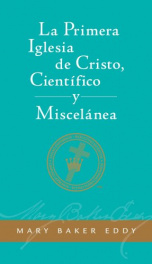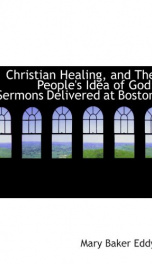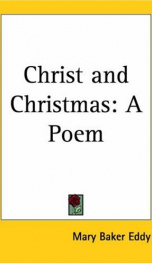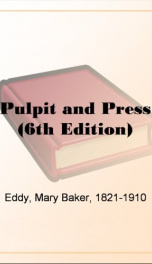Eddy Mary Baker

Mary Baker Eddy (born Mary Morse Baker July 16, 1821 – December 3, 1910) founded the Christian Science movement. She advocated Christian Science as a spiritual practical solution to health and moral issues. Accomplishments included: She and others credit her with the ability to heal instantaneously.[1] Married three times, she took the name Mary Baker Glover from her first marriage. She was also known from her third marriage as Mary Baker Glover Eddy or Mary Baker G. Eddy. Mary Baker Eddy, the youngest of the six children of Abigail and Mark Baker, was born in Bow, New Hampshire.[2][3] Although she was raised a Congregationalist, she rejected teachings such as predestination and original sin. She suffered chronic illness and developed a strong interest in the biblical accounts of early Christian healing. Starting at the age of eight, Eddy began to hear voices calling her name and would go to her mother only to be told she had not been called. In her autobiography, Eddy relates one of these later experiences: According to Yvonne Cache von Fettweis, in her book Christian Healer, "Mary's religious upbringing had taught her that all men are God's servants".[1] In her discovery of Christian Science, Eddy found that healing the sick was an integral part of Christian service. Even in early childhood, healing played a role in Eddy's life. Her family would bring ailing farm animals to her for healing. Some biographers[who?] have suggested Mary was high strung or emotional, yet reports from friends in the community where Eddy grew up corroborate reports of Eddy's ability to heal at a young age. Because of Eddy's frequent expression and confidence in God's love contrary to her father's relentless theology, she entered into a religious crisis at age twelve when she was first eligible to join the Congregational church. Her father believed in a hard and bitter doctrine of predestination and believed that a horrible decree of endless punishment awaited sinners on a final judgment day. This ultimately led to a crisis of health where her father's paternal love overtook his stern beliefs. She was healed of the fever after prayer as she wrote:[5] Mary did not join the Congregational church until she was seventeen at Sanbornton Bridge.[5] While Eddy attended the Pembroke Academy, an incident occurred which was later told by old residents of Tilton. A lunatic, escaped from the asylum at Concord and invaded the school yard. He brandished a club, terrifying the children who ran shrieking into the house. Eddy advanced toward him, and the children, peering through the windows, saw him wield the club above her head. They watched in horror, expecting her to be struck down before their eyes. But this did not happen. She walked straight up to him and took his free hand. The club lowered harmlessly to his side. At her request he walked with her to the gate and so, docilely, away. On the following Sunday he reappeared and quietly entered the church. He walked to the Baker pew and stood beside Eddy during the hymn singing. Afterward, he allowed himself to be taken into custody without resistance.[5] On December 10, 1843, she married George Washington Glover, a Royal Arch Mason.[6] He died of yellow fever on June 27, 1844, a little over two months before the birth of their only child, George Washington Glover.[6] After her husband's death, Eddy freed her husband's slaves, unwilling to accept for herself the price of a human life.[6] As a single mother of poor health, Mrs. Glover wrote some political pieces for the New Hampshire Patriot. She also worked as a substitute teacher in the New Hampshire Conference Seminary.[6] Her success there led to her briefly opening an experimental school which was an early attempt to introduce kindergarten methods (love instead of harshness for discipline; interest instead of compulsion to impart knowledge), but this, like other similar attempts at this time was not accepted and soon closed.[6] The social climate of the times made it very difficult for a widowed woman to earn money. Her mother died in November 1849 and about a year later, her father remarried Elizabeth Patterson Duncan.[6] Eddy continued to have poor health and her son was put into the care of neighbors by her father and stepmother. Eddy married Dr. Daniel Patterson, a dentist, in 1853[7] hoping he would adopt the young boy, and Daniel Patterson signed papers to that effect on their wedding day. However, he never followed through on his promise. Eddy was often bed-ridden during this period.[7] Of her sisters who were able to help her in the care of her rambunctious child, sadly, none really did, beyond short periods. Her mother had passed on and her father had remarried a woman who did not welcome either Eddy or her child.[7] A neighbor couple with a small farm and no children took up the care of the boy for a fee, during times Eddy was confined to her bed. When this couple, who found the boy useful in the farm labor, intended to move out to the Prairie territories,[7] without her knowing,[7] some of Eddy's family arranged that the couple should take the child along with money given them by Eddy's father. Eddy's symptoms worsened and plunged her into a deep depression. The failure of Patterson to make good on his promises of reunification with her now far-distant son plunged the Eddy into deep despair.[7] Her acute desire to recover her health led her to seek for healing in the various systems fashionable of the period. Eddy was ready to try anything to bring relief to her sufferings. Patterson chased after other women while married to Eddy.[7] He ran into financial difficulty and mortgaged Eddy's furniture, jewelry, and books, but was still unable to keep current on their property in Groton, and was eventually forced to vacate.[7] Patterson intended to leave Groton and Eddy's sister, Abigail, removed her from her Groton home to Rumney, six miles distant, in a carriage with her blind servant following on foot.[7] A fragile child, Mary Baker Eddy suffered intensely from a number of physical complaints. The exact nature of these illnesses, and their possible psychosomatic or hysterical (as it was called at that time) nature, is still a subject of debate. Eddy's letters from this time, now at the Mary Baker Eddy Library for the Betterment of Humanity in Boston, Massachusetts, portray her sufferings and search for relief. In October 1862 she became a patient of Phineas Quimby, a magnetic healer from Maine. She benefited temporarily by his treatment [8] and his beliefs influenced her later thinking and writing, although to what extent has been frequently disputed. Originally, Eddy gave Quimby much credit for his hypnotic treatments of her nervous and physical conditions and initially thought his brand of mesmerism entirely benign. From Quimby, Eddy was first exposed to the effects of unseen mental influences and beliefs on sick patients. While Quimby had his own notions on the nature of these unseen forces, which Eddy accepted early on, she would later draw decidedly different opinions on the nature of thought on the body and reject any form of hypnotism. After being helped by Quimby, Eddy wrote the following defense of him in the Portland (Maine) Evening Courier in the fall of 1862: "...now I can see dimly at first, and only as trees walking, the great principle which underlies Dr. Quimby's faith and works; and just in proportion to my light perception of truth is my recovery. This truth which he opposes to the error of giving intelligence to matter and placing pain where it never placed itself, if received understandingly, changes the currents of the system to their normal action; and the mechanism of the body goes on undisturbed. That this is a science capable of demonstration becomes clear to the minds of those patients who reason upon the process of their cure." On the day following the publication of the above article her views were criticized by a rival newspaper, the Portland Advertiser. Eddy wrote a second article, replying to the criticism. In it appeared the following paragraph, referring to Quimby and his doctrine: "P. P. Quimby stands upon the plane of wisdom with his truth. Christ healed the sick, but not by jugglery or with drugs…. P. P. Quimby rolls away the stone from the sepulchre of error, and health is the resurrection." This quote stands in contrast to what she would later write in Science and Health, "Glory be to God, and peace to the struggling hearts! Christ hath rolled away the stone from the door of human hope and faith, and through the revelation and demonstration of life in God, hath elevated them to possible at-one-ment with the spiritual idea of man and his divine Principle, Love." She claimed her understanding of the spiritual message of the Bible deepened and her understanding of what she called "the Christ" replaced references to personal saviors. After a severe fall in Lynn, Massachusetts allegedly caused a major spinal injury in February 1866, Eddy reported that she turned to Matthew 9:2[9] in the Bible and recovered unexpectedly. Although she filed a claim for money from the city of Lynn for her injury on the grounds that she was "still suffering from the effects of that fall," she later withdrew the lawsuit.[10]. She devoted the next three years of her life to Biblical study and what she considered the discovery of Christian Science. In her autobiography, Retrospection and Introspection, Eddy writes "I then withdrew from society about three years,--to ponder my mission, to search the Scriptures, to find the Science of Mind that should take the things of God and show them to the creature, and reveal the great curative Principle, --Deity."[4] Convinced by her own study of the Bible, especially Genesis 1, and through experimentation, Eddy claimed to have found healing power through a higher sense of God as Spirit and man as God's spiritual "image and likeness." She became convinced that illness could be healed through an awakened thought brought about by a clearer perception of God and the explicit rejection of drugs, hygiene, and medicine based upon the observation that Jesus did not use these methods for healing:
do you like this author?
What readers are saying
What do you think? Write your own comment on this book!
write a commentWhat readers are saying
What do you think? Write your own comment on this author!
write a commentBook list

Manual of the Mother ChurchThe First Church of Christ Scientist in Boston,Massachusetts
Series:
Unknown
Year:
Unknown
Raiting:
3/5
Show more
add to favoritesadd In favorites

the first church of christ scientist and miscellany
Series:
Unknown
Year:
Unknown
Raiting:
2.5/5
The First Church of Christ Scientist and Miscellany is a deeply religious book and it is intended for people devoted to religion and having a strong faith in God and believing in his eternal love for the whole mankind.
Show more
add to favoritesadd In favorites

the first church of christ scientist in boston massachusetts
Series:
Unknown
Year:
Unknown
Raiting:
3.5/5
Show more
add to favoritesadd In favorites
Book list

Manual of the Mother ChurchThe First Church of Christ Scientist in Boston,Massachusetts
Series:
Unknown
Year:
Unknown
Raiting:
3/5
Show more
add to favoritesadd In favorites

the first church of christ scientist and miscellany
Series:
Unknown
Year:
Unknown
Raiting:
2.5/5
The First Church of Christ Scientist and Miscellany is a deeply religious book and it is intended for people devoted to religion and having a strong faith in God and believing in his eternal love for the whole mankind.
Show more
add to favoritesadd In favorites

the first church of christ scientist in boston massachusetts
Series:
Unknown
Year:
Unknown
Raiting:
3.5/5
Show more
add to favoritesadd In favorites

christian science versus pantheism and other messages to the mother church
Series:
Unknown
Year:
Unknown
Raiting:
3/5
Originally published in 1908. This volume from the Cornell University Library's print collections was scanned on an APT BookScan and converted to JPG 2000 format by Kirtas Technologies. All titles scanned cover to cover and pages may include marks notations and other marginalia present in the original volume.
Show more
add to favoritesadd In favorites

christian healing and the peoples idea of god sermons delivered at boston
Series:
Unknown
Year:
Unknown
Raiting:
4/5
Originally published in 1908. This volume from the Cornell University Library's print collections was scanned on an APT BookScan and converted to JPG 2000 format by Kirtas Technologies. All titles scanned cover to cover and pages may include marks notations and other marginalia present in the original volume.
Show more
add to favoritesadd In favorites

christ and christmas a poem
Series:
Unknown
Year:
Unknown
Raiting:
3.5/5
RED LEATHER BOUND COVERS WITH RED PLACE RIBBON. 1925. Trustees under the will of Mary Baker G. Eddy. Reprint. Book-VG+. Leather Bound. Gilt titles on spine. Page edges dipped in gilt. 7.5x5. 79pp. MINOR TANNING DUE TO AGE. FEW OF ILLUSTARATIONS HAVE COLOR SMEARING. VERY NICE COPY FOR AGE AND TYPE.
Show more
add to favoritesadd In favorites

a complete concordance to science and health with key to the scriptures togeth
Series:
Unknown
Year:
Unknown
Raiting:
3.5/5
Show more
add to favoritesadd In favorites

Science and Health, with Key to the Scriptures
Series:
Unknown
Year:
Unknown
Raiting:
3.5/5
Show more
add to favoritesadd In favorites

Pulpit and Press (6th Edition)
Series:
Unknown
Year:
Unknown
Raiting:
1/5
This book was converted from its physical edition to the digital format by a community of volunteers. You may find it for free on the web. Purchase of the Kindle edition includes wireless delivery.
Show more
add to favoritesadd In favorites
What readers are saying
What do you think? Write your own comment on this author!
write a commentif you like Eddy Mary Baker try:
readers also enjoyed
What readers are saying
What do you think? Write your own comment on this author!
write a commentGenre
if you like Eddy Mary Baker try:
readers also enjoyed
Do you want to read a book that interests you? It’s EASY!
Create an account and send a request for reading to other users on the Webpage of the book!

